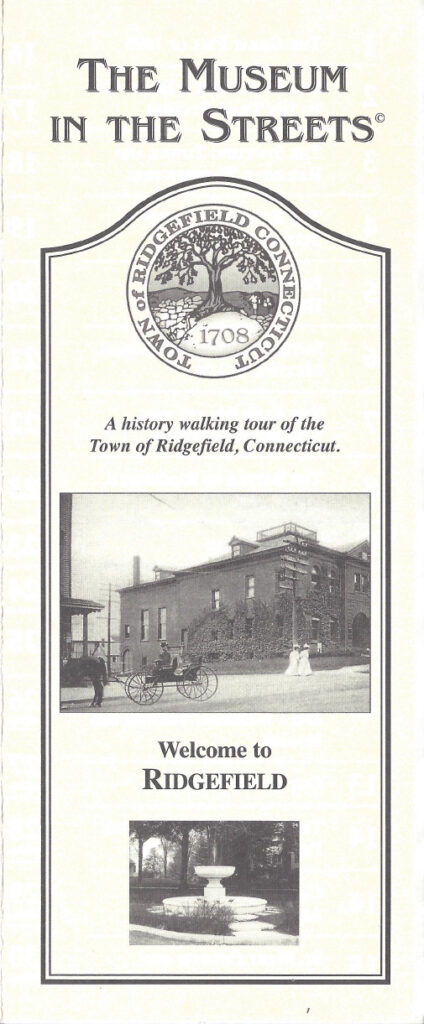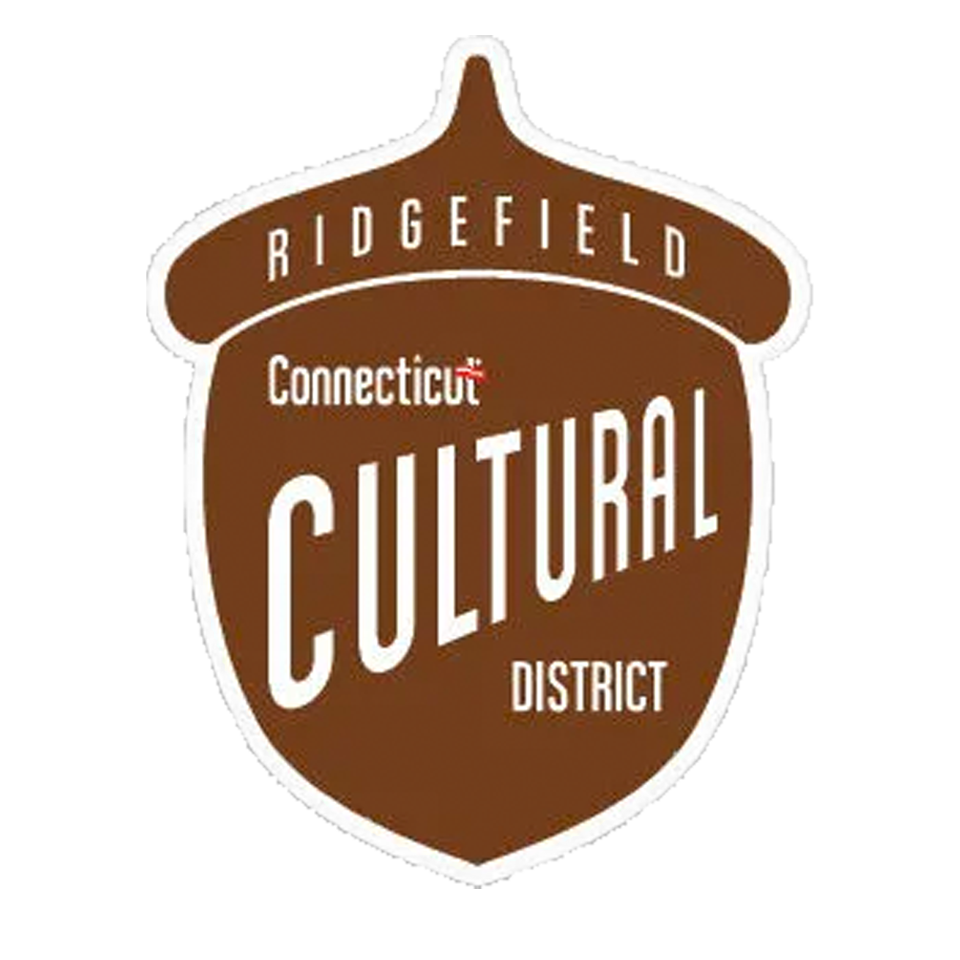The Museum in the Street
Immerse Yourself in History
The Museum in the Streets installation, created and organized by the Ridgefield 300th Anniversary Committee 2008, is a heritage discovery trail for the community and its visitors. The walking and driving tour seeks to enhance the community’s historical identity, educate, encourage preservation and promote the knowledge and respect of local traditions. Featuring permanent markers at 32 ‘stations of history,’ Ridgefield’s Museum in the Streets brings the past to life beyond the walls of traditional institutions.
In 2015 the Ridgefield 300th Anniversary Committee turned the Museum in the Streets installation over to the Ridgefield Historical Society. The Historical Society acquires, preserves, catalogs, and disseminates informational resources concerning the history and architecture of Ridgefield and conducts research and educational projects. For further information, contact us at (203) 438-5821 or [email protected]
Welcome to Ridgefield
The Fundamental Orders adopted by Connecticut in 1639 allowed would-be settlers, able to support a minister, to establish a settlement, build a Congregational Church and farm the land. This is exactly what was done here in 1708. The original 24 proprietors received 7 1/2-acre home lots drawn by lottery, with a 25th reserved for the minister. The lots were located north and south along a wide main street on one of the three ridges that would give Ridgefield its name. The close-knit community lived under the vigilant eye of the Rev. Thomas Hauley, who also served as schoolmaster and town clerk. Each family was an individual survival unit, dwelling in a small home, farming its outlying fields, and husbanding a few farm animals on its home lot.
The 18th century was a busy time for the new community: homes and mills were built, schools and small businesses were established, and most importantly in 1775, after thrice declining to do so, the town fathers voted to oppose King George and the English government, and became part of the fight for liberty. In April 1777 a British raiding party, under the command of Gen. William Tryon, landed at Compo Beach in Westport with orders to march to Danbury where they sacked and burned the town, destroying the patriot supplies stored there. On their march back to the sea, they passed through Ridgefield where they were met by a hastily formed army led by Gen. David Wooster, Gen. Gold Selleck Silliman and Gen. Benedict Arnold (then still an American patriot.)
After the war the pace of commerce grew. By 1822 the town had weavers, hatters, tailors, cab inet makers, silversmiths and shoemakers. Immigrants arrived from Ireland and Germany. The 19th century also saw the birth of industry, including carriage manufacturing. By 1830 the Resseguie and Olmstead carriage “manufactory,” later called the Big Shop, became one of the town’s largest employers. During the Civil War the Connecticut 17th Regiment included young men from Ridgefield, who served in many battles, including Chancellorsville and Gettysburg.
A half dozen died on the battlefield or in Confederate prisons. In the early 20th century the face of the town began to change: Italian immigrants arrived and built roads and the water system and worked on the great estates. Prominent artists, actors and writers also found homes here. By mid-century the biggest change came in the form of “com muters,” who found a beautiful small town, affordable housing and a relatively easy com mute by car or train to their offices in Stamford, Westchester and New York City. During the last half of the century, the population grew from 10,000 inhabitants to its present 24,000 plus.
On September 30, 2008 Ridgefield began a nine months long series of events to celebrate its 300 years. We trust that the original 25 proprietors would be pleased at the transition our town has made from the small farming community they carved out of the wilderness into a caring town intent on remembering our past.
—Written by Kay Ables and Tom Belote
In 1775, after thrice declining to do so, the town fathers voted to oppose King George and the English government.
By 1822 the town had weavers, hatters, tailors, cab inet makers, silversmiths and shoemakers. Immigrants arrived from Ireland and Germany.
During the last half of the century, the population grew from 10,000 inhabitants to its present 24,000 plus.
Thank You to Our Sponsors
The Museum in the Streets project has been sponsored by:
Adam Broderick Salon & Spa
Aldrich Contemporary Art Museum
The Amatuzzi Family
Frank Ballatore @ New England Computer Group, Inc.
Tom & Jane Belote
Branchville Oil Company
Carnall Insurance
Carroll Construction
Nick Cemprola-Nutmeg Livery Service
Colonial Cleaners
The Craig Family
The Dubitsky/Dean Family
The First Congregational Church
Fountain Committee
John Katz
Keeler Tavern Museum
The Historic Lounsbury House at the Ridgefield Community Center
Paul & Dewey McNamara
Rebecca & Stephen Mucchetti
Annette & Dan O’Brien
John & Joanne Patrick
Reynolds & Rowella, LLP
Ridgefield Bank, a Division of Fairfield County Bank
Ridgefield Chamber of Commerce
Ridgefield Hardware
Ridgefield Historical Society
Ridgefield Supply Company
Ridgefield Woman’s Club
The Town of Ridgefield
The Scala Family
Lonnie Shapiro
The John Sturges Family
The Toy Chest
Union Savings Bank
Patrick & Kathleen Walsh Family
Webster Bank
Peter & Beth Yanity
Stephen Zemo
Our sincere thanks to the following individuals and organizations who have donated photographs from their collections to the Museum in the Streets installation, and to many notable Ridgefield citizens who have documented the history of Ridgefield throughout the years:
Carol Ancona
Silvio Bedini
Virginia Cohen
Morton Dean
The First Congregational Church
Charles Fisher
Samuel Goodrich
David Hein
Edward Karvosky
Keeler Tavern Museum
Korker Archives
Stephanie Pelletier
Ridgefield Highway Dept.
Ridgefield Historical Societ
Ridgefield Parks & Rec. Dept.
Ridgefield Press
George Rockwell, Jr.
Kathryn Rosa
Jack Sanders
Lucy Scala
David Scott, AJA
Barbara Serfilippi
Gary Singer
Mary Sullivan
Daniel W. Teller
Richard & Marie Venus
Barbara Watso
Glenna Welsh
Josette Williams





